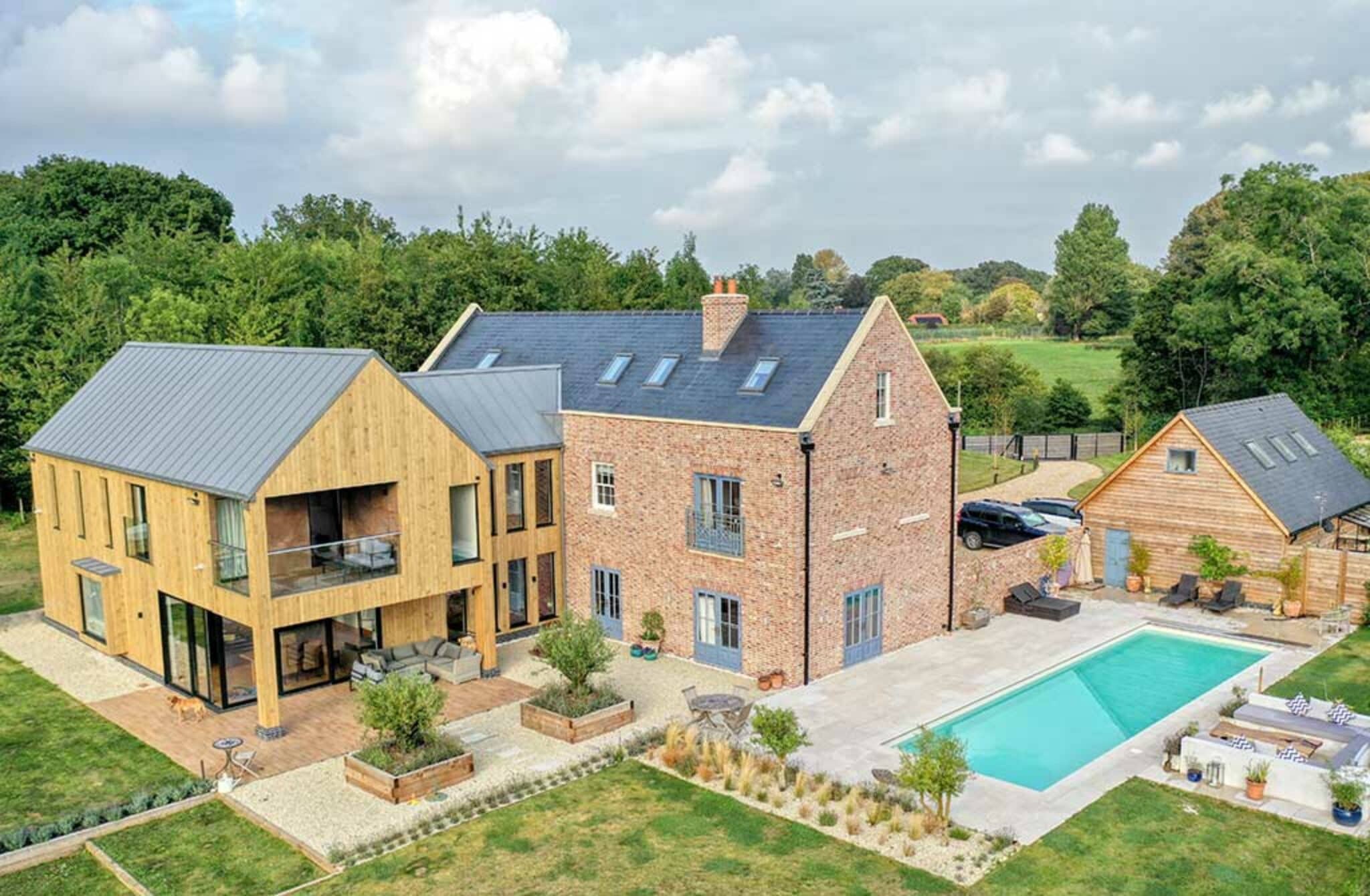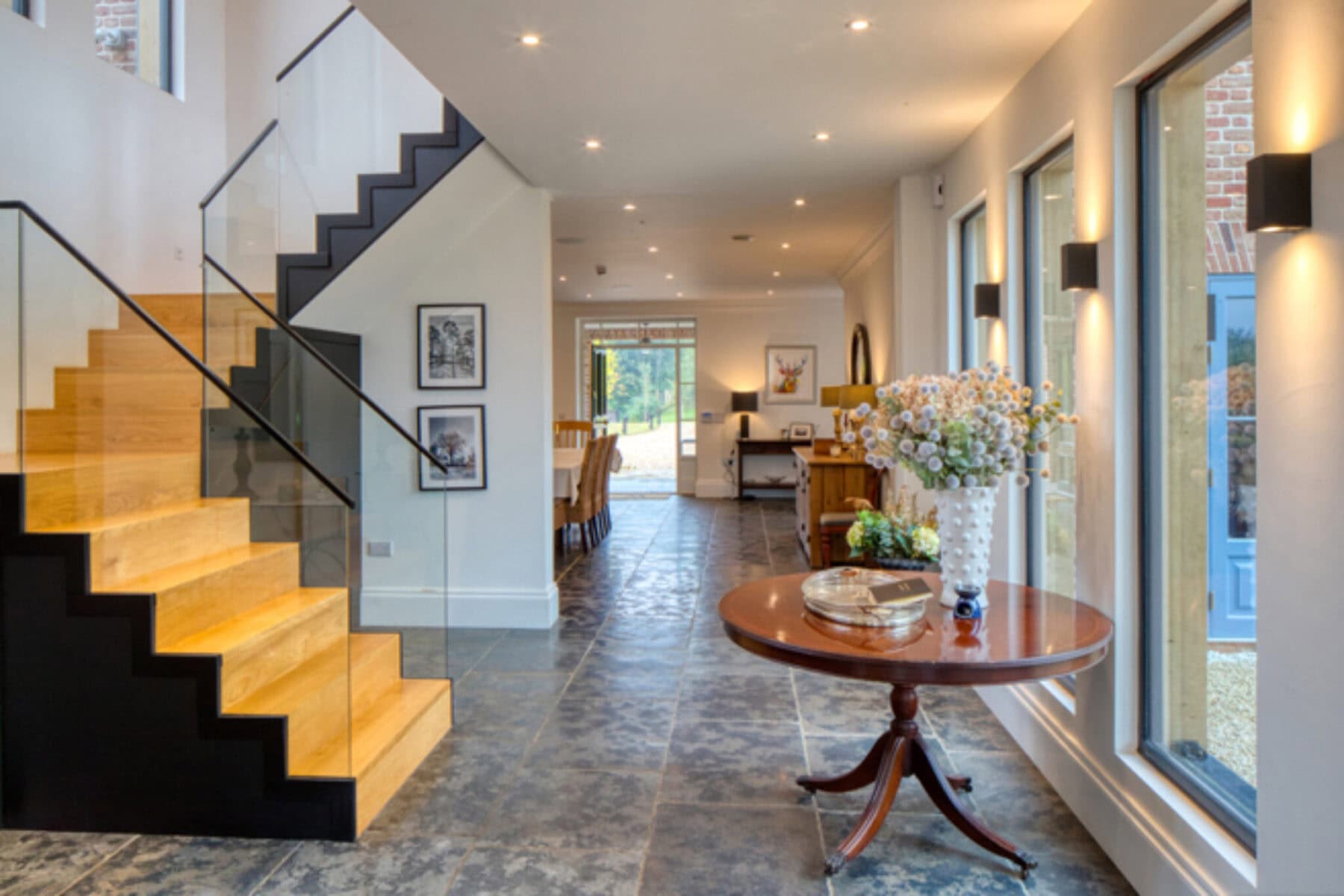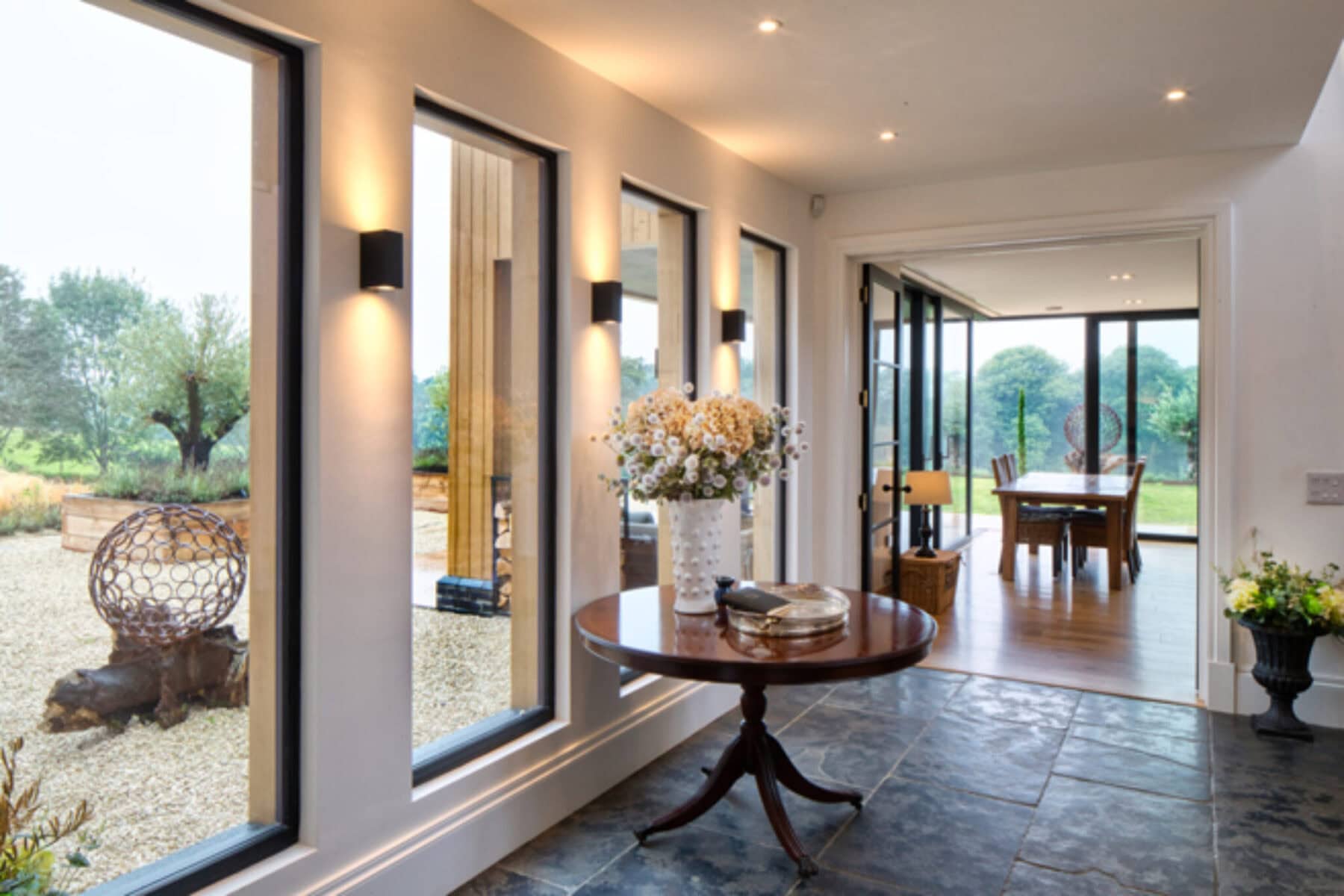Sympathetic self-build for conservation village
Richard and Beth Wilson were second-time self-builders when they approached Fleming Homes with their ambitious project in the village of Newnham, in rural Hampshire. Their 10-acre site was on the edge of a conservation area. The Wilsons had met, married, and brought up their family in the village, and it was important for their design to be sympathetic to the natural surroundings.

They also wanted a design that made the best of the light, including spacious open-plan areas for family living. This called for a combined approach, says Richard. “We designed a two-building concept that juxtaposes a prefabricated ‘old’ farmhouse with more contemporary modern living at the rear. The Georgian-style frontage uses Flemish Bond brickwork, with lime mortar and tumbled bricks. The parapet walls and timber sash windows also help to give it the hallmarks of a long-established English country house with a period feel.”
Meanwhile, the rear modern section is more reflective of 21st-century architecture and design. “Our home has been described as ‘traditional at the front, party at the back!” says Richard. “The rear section has large vertical glazed areas with black aluminium clad windows. The east-west orientation means we get maximum benefit from the solar gain and thermal efficiency, as well as making the best of the views. We chose honey-coloured Accoya wood cladding for the rear, to give a smooth, clean finish, and the floor-to-ceiling glass hall and feature staircase create flow between the two sections.”


Timber frame speed to wind-and-watertight
Beth says the design scale played a big part in their choice of timber frame for their self-build. “We researched different build systems. There wasn’t a significant cost difference, but there was a sizable difference when it came to time. The structural system gave us a speed of construction which was critical to the success of such a large-scale build (526m2). We also realised that achieving structural erection in a short window would give us much more control over the build schedule.”
In the event, their timber frame kit arrived in September 2018, and it took just four weeks to get to wind-and-watertight. “Getting to WAWT so efficiently meant we could complete cladding and brickwork during the autumn, and follow-on trades could move inside during the cold winter months,” says Beth. “It was a very effective approach for us, as we were project managing, managing individual trades, and also had demanding day jobs.”
The house was ready to move into twelve months later, on 24th July 2019, with final cosmetic works and landscaping completed in 2021.
The couple’s research and planning meant that by the time they met Fleming Homes at the National Self-Build Show in Swindon, they had already started the process of securing timber frame quotations.
“We were just leaving after a busy day at the NSBRC show in Swindon,” says Beth. “Flemings had a picture of a house with a nice balcony, and we got talking to Sarah. We were time-constrained, and we already had some prices in from other timber-frame manufacturers. We needed to be able to compare prices on a real “apples to apples” basis, as there are such different standards of installation and what’s included. Flemings got their price to us in a couple of days, and we had a call going through the list so that we could compare quotes. Flemings were very responsive and very proactive. It was so different from going to a larger company. The service and ethos of the company really sold it to us – it was clear they really wanted to be part of the journey.”
The Wilsons were also reassured by speaking to happy Fleming Homes customers. “We felt that Flemings were really good at building relationships”, says Richard. “They’re a small, tight-knit company, and you aren’t just a number. Making a decision on a house can be life-changing and let’s face it, we aren’t professionals. They’re dealing with amateurs day in, day out, but they make you feel special. They’re very busy, and the usual temptation for a small company is to take on more, but they’ve chosen not to do that, so they don’t over-expand. The ethos and the customer journey are so important to them.”
Proactive Self-Build Problem-Solving
Beth explains that planning permission was in place before they came to Fleming Homes. “We used a planning consultant locally because we’re in a conservation area. So, we had a basic set of drawings done. But Flemings obviously put together all the designs for us, and all the necessary drawings. They helped if we needed clarification on anything for the planning office, and were on the end of the phone when it came to dealing with the individual trades.”
“Because we were project managing, we didn’t have an architect, we didn’t use a quantity surveyor – we didn’t use a lot of the professional services that some individuals or people may do. So actually, getting the right support from Fleming Homes was really important, and hugely valuable.”
This expertise turned out to be crucial for speedy problem-solving on the ground.
“They helped us through some really sticky situations,” admits Richard. “For example, we have flush thresholds the whole way round. No steps into and out of this house anywhere. And that’s actually quite difficult! I’m standing there, and I’ve got our ground workers, who are trying to build the slab to the level that we want. And they’re saying they can’t put the cladding to the floor because it could potentially rot.”
“I got on a call with Flemings and our groundworker company, about the depth of the damp proof course. It had to be correct for sign-off from a building perspective, and also so that the floor finish was right for when the frame came in. Those details are very technical, and we didn’t have a single builder who would take ownership of that – we had to own a lot of that stuff. That ended up being a half-hour conversation, and it was resolved.”
Hands-On Design and Structural Support
Flemings’ problem-solving also made all the difference to the house interior, Richard says. “We designed the house without an architect, and the staircase was at the maximum that’s allowed for residential. Any wider and it would have come under commercial regulations. We spent a good deal of time working out how to create a staircase to give the impact we wanted. But once the house was up, it turned out the staircase would have protruded into the secondary hall, spoiling the aesthetic.”
“So, we went to Scott at Flemings and said, “we can’t get the stairs to work”. He was very calm and said, “don’t worry, it’s fine.” It wasn’t their issue at all, but they were very happy to work with us to fix it. And they fiddled around, changed the tread depth, and got it to a point where we could give the design to the staircase company to say, “that’s what we need”. Afterward, we heard it was a nightmare, but you’d never have known from his face! They didn’t allow us to compromise on our vision and spent time making sure we got the outcome we wanted and didn’t charge extra for this.”
Scott and Richard also helped solve the spec of the log burner aperture in the middle of the house. “That was another of those phone calls,” says Beth. “The log-burner needed a wider aperture in between two buildings on a load-bearing wall. Flemings said, “don’t worry, we’ll come back to you with instructions.” They came back literally the next day with instructions of where to cut out, where to reinforce, how to reinforce. Having that expert support from a structural team that understands the products is invaluable. It saved us a lot of time and money.”
Planning Office Reapplication
Once the Wilsons’ new home was complete, the Fleming Homes teams also helped solve issues with the planning department.
“We had quite a pedantic planning officer,” says Beth. “We ended up doing a full reapplication after we’d built the house, because of almost retrospective planning. It wasn’t actually to do with the house. It was because our property was on what was an agricultural field, and he said we’d breached domestic curtilage. He also picked up a couple of minor things about the detail of the balcony and the windows.”
“We were able to get Flemings to redo the drawings so that we could submit an accurate set of drawings back to the planning office. They didn’t charge us anything extra for it all, which was amazing. If we’d have gone back to a technical drawer or designer or an architect, we would have been charged a tremendous amount of extra money for that.”
Summing Up the Fleming Homes Experience
Flemings have this wonderful Borders’ phrase and attitude, which is summed up by “nae bother!” says Richard. “We think they should get this on a T-shirt. Nothing was any trouble, and they were very proactive. They were always pointing out what we’d need and sorting it. You’d never have to chase them up and say, “we need this now!” “We’re both big, big fans!” says Beth. “Hayden was always on the end of the phone and wanted us to call him, rather than fret about something. We both believe we’ve got another house in us at some stage over the next ten years. We’d have to have a very good reason not to go with Fleming Homes again.”
Beth and Richard Wilson spoke to Jules Horne, at Texthouse.